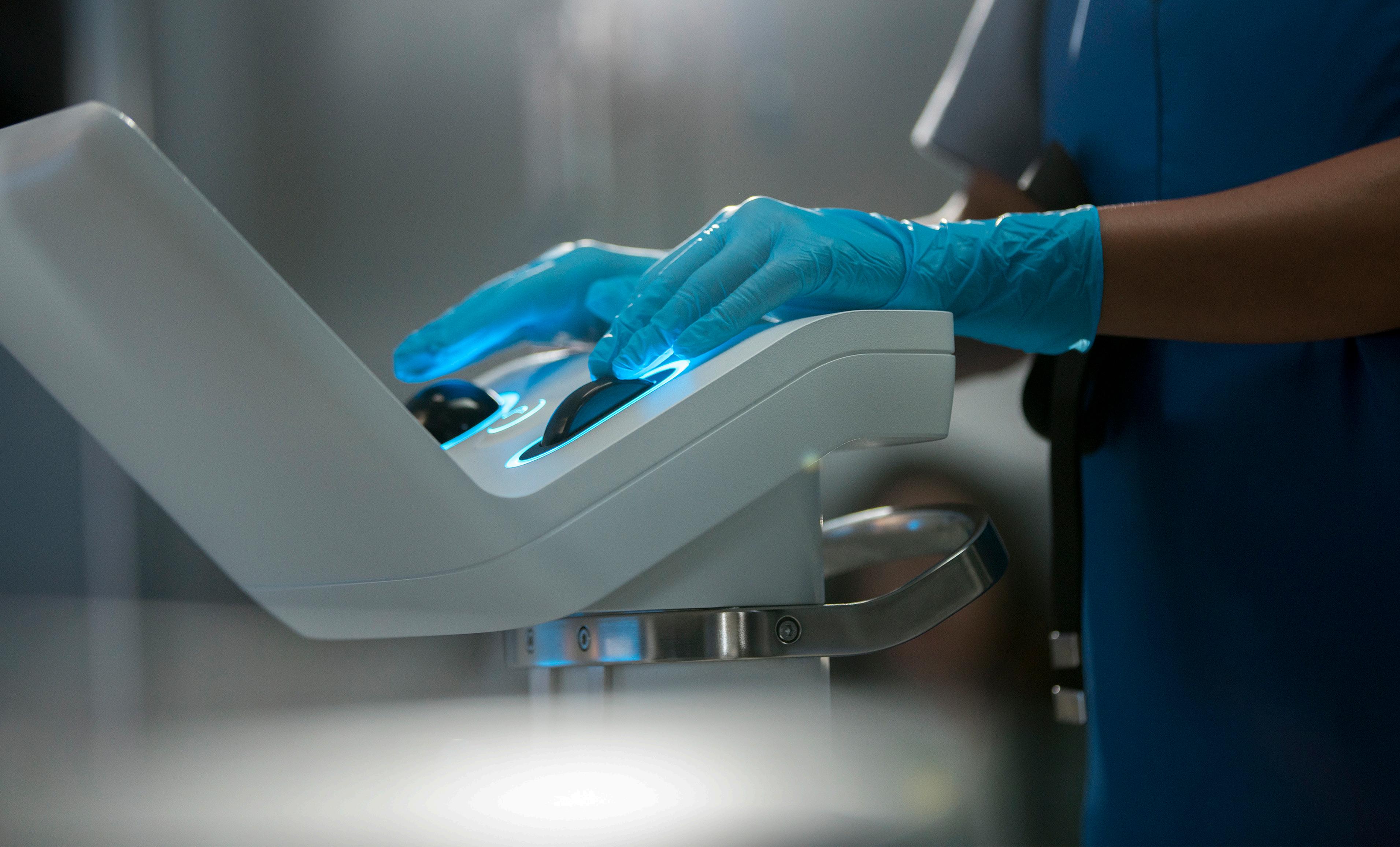
8 minute read
Perfectly Right or Perfectly Wrong: Sometimes Design Feels Like Space Flight
MODERN MEDICINE
PERFECTLY RIGHT OR PERFECTLY WRONG: SOMETIMES DESIGN FEELS LIKE SPACE FLIGHT
On the subject of space flight, Chris Hadfield once said, “For an astronaut, especially at launch, half of the risk of a six-month flight is in the first nine minutes.” That’s putting it lightly. Underneath his calm demeanor, I think he is sharing an intimate moment with us. After years of dreaming and aspiring to reach space, you find yourself at last on the launch pad moments away from everything you’ve trained so hard for. You climb into your rocket—which you know is actually a bomb that will either explode perfectly right or perfectly wrong—and in this moment the main question on your mind will be, Wait, what the hell was I thinking?
I remember a similar feeling in 2014 when I joined Intuitive Surgical as its first in-house industrial designer. I sat down at my cube, looked up into my future and dreamed about the studio we would build, the designers we would hire and the amazing things we would do. Then I looked back down at my cube.
The intuitive experience inside the console is contrasted by the physical complexity that makes it all work.


There was no question that this was the place for me. Long before I arrived, this medical technology company had already designed, developed and manufactured the first four generations of the da Vinci Surgical System, which combine robotics and immersive 3D visual technology to enable surgeons to operate inside the human body with enhanced vision, precision and dexterity.
As a designer, I found sitting behind the console of a da Vinci System for the first time almost transcendent. The core of this experience is a skillfully crafted human-tomachine synchronization where the system is guided by the surgeon as a natural extension of the surgeon’s eyes and hands. It is undeniably a labor of love, an inspirational act to design an interaction like this—to make a machine and a human being fit together so well. I could recognize what a triumph it was. I walked away from that first demonstration wondering, How can we make every part of using the system feel as natural and intuitive to users?
Don’t Bounce Off, Don’t Burn Out Intuitive made the decision to build an in-house ID team because leadership saw design in its future. That was the spark, but the path was undefined. It was humbling in those early days to take in over 20 years of innovation and ask how ID could possibly improve upon it. My sense was this would be the fun part. The hard and risky parts would be managing a transition from a design-as-service model (the consultant model Intuitive had previously employed) to a model that would launch and sustain an in-house design team. We needed to build the space, the capability and the trust from scratch. We knew there was huge potential, but first there was much to learn.
It turns out that the first and most valuable lesson was humility. Even those of us who had backgrounds in medical device design had never been involved in something as complex as this, from the advanced robotics in the system to the workflows and norms of the operating room. We had
MODERN MEDICINE

The iconic ergonomic profile for the controller for the Ion Endoluminal System was developed as a tight collaboration between industrial design, human factors, clinical and technical teams.

to go back to basics. We had to build relationships. We had to learn about the product, the workflows and the industry.
Design needed to reach out for knowledge and learn from others to earn trust and build understanding. Today, as we continue to build our team, we look for this capacity in a designer. We know we are going to give them a lot to learn and challenge them to grow—no matter where they come from and what they’ve achieved in the past.
This kind of humility is the core of how human-centered design works, and this is the basis of good design. When we work this way, we include others and build consensus. We go outside of ourselves and our comfort levels. We base our decisions in iteration and observation and move forward together confidently as a team. We become great collaborators and great partners furthering Intuitive’s overall mission of striving for better patient outcomes. There is no better way. A lesson in humility is also a lesson in design.
The second lesson we learned as a group was to be ourselves and speak up. It was vital to bring a designer’s perspective to the teams we were working with, and from the beginning certain things needed to be discussed for ID to have a path to success. We found that when we strengthened existing values, the road was smooth and comfortable, but proposing new values often gave rise to more bumps in the road.
This is often where designers fail. A metaphor I refer to often is that this is like a space capsule reentering the atmosphere: Come in too steep and you will burn up. Come in too shallow and you will bounce off. Finding the balance between being humble and empathetic enough to connect and blend with the insight of others and confident and capable enough to motivate others into new territory—that was the ultimate project.
The hardest thing about speaking up is knowing when and how to do it. Don’t let that stop you. It is a natural instinct to reflect the language and voice of the majority in order to get by. It’s true that when collaborating with engineers a designer must learn the language of engineering. It’s also true that the designer must be brave enough to find and use their own voice to ask questions and share views. Something important is lost if they don’t. It is difficult to keep that steady, balanced angle of approach, blending with others and sharing our views, but that balance is required.
Enter the Atmosphere The results are better when everyone speaks and understands each other’s language. While we have been creating products together at Intuitive, we have also been creating culture. One particularly steep learning curve at Intuitive is vocabulary. There are acronyms for everything. A designer must grapple with the laws of inverse kinematics and robotics while also grappling with how to pronounce “pneumothorax” properly in a room full of thoracic surgeons. It can be tough, but once designers absorb these concepts
The da Vinci SP Surgical System.


for themselves and can converse in these terms, their ability to collaborate improves.
For our part as designers, we’ve added a few terms into the mix. Now it is not unusual to hear words like “intention” and “affordance” spoken by non-designers in feature prioritization meetings. The key to culture is the shared ownership of values. It is here where we have seen the power of language in culture as well as the necessity of speaking your words.
Words alone aren’t enough, though, especially when it comes to design. We say in our design group, “Show me don’t tell me.” This phrase emphasizes the essential fact that the work is where the truth is. In any medical device company, the designer’s work will be challenged and questioned relentlessly, and in that sense, it will be purified. Never wait to give form to your ideas, and bias toward action. Share your ideas before they become too precious. Bring all your senses into the conversation. This is often where the real dialog begins.
Stick the Landing Over the past year, the da Vinci SP System and the Ion Endoluminal System have won many awards. It is a boost for our design team to be recognized by our peers—an even bigger boost to see our work embraced by the physicians for whom we design. We can’t describe the satisfaction that comes from designing for the well-being of others. These systems are the first of what we intend to be a long legacy of in-house design at Intuitive, where we strive to present the best industrial design can offer in concert with uncompromized engineering, clinical functionality and human factors and the influence of the clinicians and care providers who partnered with us. You see all of Intuitive in this remarkable technology, not just Intuitive’s design group.
I feel like the health industry is about to experience the beginning of a golden age for design. While design flourishes over the next decade, with exciting technologies coming into play and medical device companies investing in design like never before, many designers will be finding their way. They will find the opportunity to start something meaningful and to grow and learn, and they will bravely risk those first nine minutes and adapt their approach along the way. I am excited for the coming decade of exploration and accomplishments in healthcare—and perhaps equally excited for the lessons this industry has to teach our profession. By exploring what design can bring to healthcare, we will discover so much about design.
—Tim Hulford, IDSA Tim.Hulford@intusurg.com
Having always worked at the forefront of human-centered design and technology, Tim Hulford is the founding member and creative director of industrial design at Intuitive.






